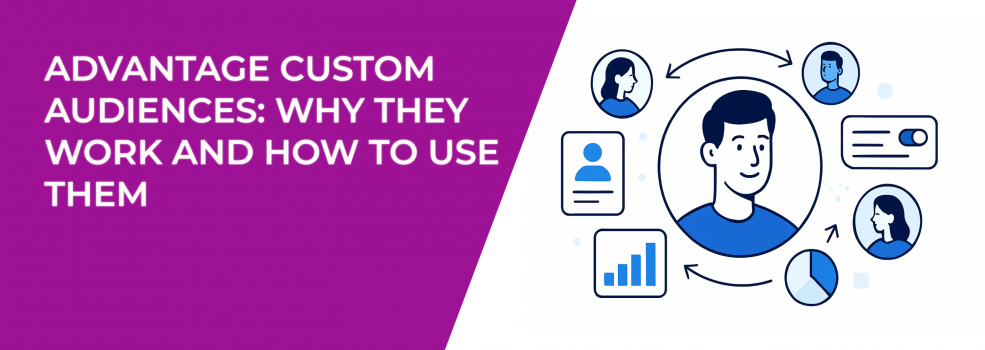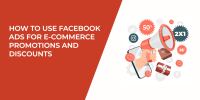If you’ve run Facebook or Instagram ads lately, you’ve probably noticed something: audience targeting is changing. Privacy updates, platform rules, and new ad tools are reshaping how we reach the right people.
One feature you may have seen in your Meta Ads Manager is Advantage+ Custom Audience. It sounds technical, but it’s actually a very practical tool that can help you scale results without losing control.
This article breaks down what Advantage+ Custom Audiences are, why they’re effective, and how to use them the right way. We’ll also give you simple, proven strategies to get better performance from your Facebook and Instagram ads.
What Is Advantage+ Custom Audience?
Advantage+ Custom Audience is a targeting feature in Meta Ads. It allows Meta to expand your custom audience — such as past customers or website visitors — and find more people who behave similarly, even if they weren’t originally in your list.
Think of your custom audience as a starting point, not a hard limit. Meta uses it to understand who your ideal customer is, and then automatically finds more people with similar behaviors and intent.
For example, you can upload a list of 1,000 past customers. Instead of only showing your ads to those exact people, Meta uses Advantage+ to reach others who are likely to buy based on similar traits and actions.
This makes it different from traditional lookalike audiences. With lookalikes, you choose the match percentage manually (like 1% or 5%). But with Advantage+, the algorithm adjusts in real time to optimize your results.
Why Advertisers Use Advantage+ Custom Audiences
Advertisers are using Advantage+ more and more — and for good reason. It offers real benefits that can improve your campaign results without overcomplicating your targeting setup.
Here are some of the main advantages to using it:
-
Wider reach without sacrificing relevance. It helps you scale your campaigns without showing ads to totally random users. Meta’s system expands your reach intelligently — guided by your custom audience.
-
Better use of first-party data. Your customer data is one of your most valuable assets. This tool lets Meta extract more value from it, helping you reach people who are most likely to act.
-
Dynamic, performance-based targeting. As your campaign runs, Meta adjusts who it shows your ads to based on performance. It learns what’s working and improves delivery automatically.
-
No need to manually test audience variations. Instead of building multiple lookalike segments and running A/B tests, you can let Advantage+ do the heavy lifting behind the scenes.
If you’ve been struggling with limited reach or inefficient scaling, this feature is worth testing. It's designed to work behind the scenes but when used right, it can have a noticeable impact.
When Should You Use It?
Not every campaign needs Advantage+, but it works best when your goals and data are aligned. So when does it make the most sense?
Consider using Advantage+ Custom Audiences in these situations:
-
You have a strong source audience (like purchasers, leads, or highly engaged users).
-
You want to scale results without losing precision or relevance.
-
You’re running campaigns for awareness, traffic, engagement, sales, or lead generation.
-
You want to simplify audience setup and let Meta optimize delivery for you.
If your campaigns check off two or more of the points above, you’re likely in a great position to benefit from this feature.
Not sure whether to retarget or go broad? This breakdown of retargeting vs. broad targeting can help you decide when to let Advantage+ do the work — and when to keep your focus narrow.
How to Use Advantage Custom Audiences
Let’s walk through a practical, step-by-step guide for setting up Advantage+ Custom Audiences inside your Meta ad account. These steps will help you build a foundation for better performance.
1. Choose a strong custom audience
Start by selecting a high-quality audience that matches your campaign’s goal. The better your source data, the more effective the audience expansion will be.
Good examples include:
-
Purchasers from the last 30–90 days,
-
Leads from your CRM,
-
People who added to cart but didn’t check out,
-
Website visitors who spent the most time on key product pages,
-
Users who engaged with your Instagram profile or Facebook Page.
Pro tip: avoid weak or outdated audiences like “all site visitors from the last year.” The more relevant your audience, the more accurately Meta can find similar users.
2. Create your campaign with a clear objective
Your objective tells Meta what success looks like — and influences how the algorithm expands your audience. Choose from one of these eligible campaign goals:
-
Awareness,
-
Traffic,
-
Engagement,
-
Sales,
-
Leads,
-
App promotion.
Make sure the objective you choose matches your actual business goal. If you want purchases, select "Sales." If you want installs, go with "App Promotion."
3. Enable Advantage+ Custom Audience
Next, head to the audience section during ad setup. Select your custom audience, then look for the option that allows Meta to expand delivery.
Turn on the toggle for Advantage+ Custom Audience. This lets Meta go beyond your list using it as a smart guide rather than a fixed boundary.
Keep in mind: your other filters — like age, location, and language — still apply. Meta won’t expand outside those unless you change them manually.
4. Avoid over-targeting
Try not to layer too many restrictions on top of your audience. While it’s tempting to narrow your focus, this can limit Meta’s ability to find similar users.
Keep your audience structure simple. That gives Meta’s system more room to explore and optimize for results.
If you're using manual targeting instead of Advantage+, you still need to avoid going too narrow. Here’s how to layer detailed targeting the right way without killing your reach.
5. Monitor performance closely
Once your campaign is live, track its performance carefully. Use key metrics to decide whether the Advantage+ expansion is helping or hurting.
Look at:
-
Cost per result (purchase, lead, click, etc.),
-
CTR (click-through rate),
-
ROAS (return on ad spend),
-
Frequency (how often your ad is shown to the same user).
If your results improve, you’re on the right track. If not, test a different custom audience or simplify your structure to give Meta more flexibility.
Real-World Use Cases
Still unsure how Advantage+ fits into your strategy? Let’s look at a few common, real-world scenarios where this tool can be especially effective:
Use Case 1: Scaling eCommerce Sales
You run an online store and have a list of recent customers. Instead of only retargeting those customers, you enable Advantage+ to find similar users — helping you grow your customer base while maintaining strong ROAS.
Use Case 2: Generating Leads for a Service
You’re a service provider — maybe in coaching, real estate, or consulting. Upload leads from your CRM and run a lead generation campaign. With Advantage+, Meta targets similar users who are likely to sign up.
Use Case 3: Promoting a New App
You’ve launched a new mobile app. You create a custom audience from people who visited your app landing page. Meta uses that as a starting point to find others who are likely to install and use the app.
Use Case 4: Re-Engaging Cold Leads
You have a list of old leads who never converted. Upload that list and run a new engagement campaign. Meta expands it with Advantage+, helping you reach warmer leads who are more likely to take action now.
Each of these examples shows how Advantage+ isn’t just for big budgets — it works just as well for small businesses looking to make their data work harder.
Extra Tips for Better Results
To get the most out of Advantage+ Custom Audiences, you need more than just good setup — you need smart habits.
Here are a few tips to help you keep improving.
-
Use high-intent signals. Build your custom audience from users who took meaningful actions — like purchases, form submissions, or checkout initiations — not just likes or video views.
-
Keep your data fresh. Update your custom audiences regularly. The best results often come from recent actions (within 30–90 days).
-
Test multiple audiences. Try uploading different lists (purchasers vs. leads, for example). Run them in separate ad sets to compare how each performs with Advantage+.
-
Pair with Advantage+ placements. Let Meta show your ads across Facebook, Instagram, Messenger, and Audience Network. This broader delivery gives the algorithm more data to work with — and more ways to win.
These tips don’t take much extra time but they can lead to better performance, lower costs, and smarter optimization over time.
Final Thoughts
Advantage+ Custom Audiences are one of Meta’s most powerful (yet underused) features for scaling campaigns. If you have quality data and a clear goal, they can help you grow your results without extra effort.
The key is to feed the algorithm the right signals, choose the right objectives, and give it enough space to learn. Then keep an eye on the numbers and keep testing.

